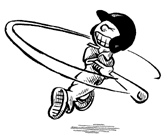
|
Physics and Acoustics of Baseball & Softball Bats
Daniel A. Russell, Ph.D. Graduate Program in Acoustics The Pennsylvania State University The contents of this page are ©2003-2011 Daniel A. Russell | 
|

|
Physics and Acoustics of Baseball & Softball Bats
Daniel A. Russell, Ph.D. Graduate Program in Acoustics The Pennsylvania State University The contents of this page are ©2003-2011 Daniel A. Russell | 
|
| This article about metal bats and safety is limited to a discussion of adult baseball bats that are currently required to pass the NCAA and NFHS performance standard which effectively, though indirectly, limits the maximum speed that a metal bat can hit a baseball. This discussion does not pertain to metal adult baseball bats manufactured prior to 1999 since those bats are not currently legal for play. This discussion also does not pertain to the smaller diameter youth bats (approved for use in Little League Baseball) which are indirectly regulated through the BPF 1.15 standard. Finally, this discussion does not pertain to the performance of "Senior League" large barrel (2-5/8-inch diameter) youth baseball bats because these bats are not currently subject to any performance standards at all, though youth baseball associations and researchers are investigating validity of extending the NCAA BESR and MOI standards to these shorter and lighter youth bats. |
The typical arguments in favor of banning metal bats, arguments that metal bats present a dangerous and intolerable safety risk, usually rely on two assumptions:
The speed with which a baseball leaves the bat (the Batted-Ball Speed) depends on three factors: the pitched-ball speed vball, the bat-swing speed vbat, and the Ball-Exit-Speed-Ratio (BESR) which represents the effectiveness of the collision between bat and ball. The Batted-Ball Speed may be easily calculated from:[2,3]
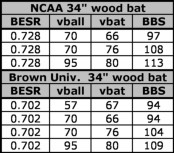 This 97-mph batted-ball speed does not, however, represent the maximum speed that this wood bat can hit a baseball. If a stronger player was able to swing the same bat with a bat-swing speed of 76-mph at a 70-mph pitched ball, the batted-ball speed would increase to about 108-mph*. And, if a major league player swung this same wood bat with a typical bat-swing speed of 80-mph towards a 95-mph fastball, the batted-ball speed could easily be as high as 113-mph. In fact, in order for a ball to just barely clear the wall for a homerun in most major league ballparks, a baseball must leave the bat with a minimum speed of at least 110-mph, and this happens with considerably regularity. So, wood bats can hit balls with excessively high speeds.
This 97-mph batted-ball speed does not, however, represent the maximum speed that this wood bat can hit a baseball. If a stronger player was able to swing the same bat with a bat-swing speed of 76-mph at a 70-mph pitched ball, the batted-ball speed would increase to about 108-mph*. And, if a major league player swung this same wood bat with a typical bat-swing speed of 80-mph towards a 95-mph fastball, the batted-ball speed could easily be as high as 113-mph. In fact, in order for a ball to just barely clear the wall for a homerun in most major league ballparks, a baseball must leave the bat with a minimum speed of at least 110-mph, and this happens with considerably regularity. So, wood bats can hit balls with excessively high speeds.
However, not all wood bats are of the same quality as the NCAA professional grade reference wood bat. In fact, one frequently repeated complaint of minor league professional baseball players is a difficulty obtaining good quality wood bats. A large number of modern MLB players use maple bats instead of ash, while most players in the Babe Ruth era used heavy hickory bats. Maple and hickory are harder woods than ash, and the greater strength means that maple and hickory bats don't break as often as ash bats do. But, maple and hickory bats tend to be heavier and most players prefer lighter weight bats because a lighter bat can be swung with greater control. Recent problems with the emerald ash borer beetle are threatening the availability of quality ash for baseball bats, and the availability of good ash for baseball bats may be a serious concern in the near future. Bat manufacturers reserve the highest quality wood for professional players, with lesser quality wood used for minor leagues and wood only college leagues, and even lesser quality wood for youth bats, like the ones you can buy at your local sportings goods store. Differences in the quality of wood translate into differences in performance.
For example, the wood bat used in the Brown University field study[4-6] has a BESR value of 0.702, which is significantly lower than the 0.728 value for the NCAA reference bat. The calculated BBS for this wood bat, assuming a bat-swing speed of 66-mph and a pitched-ball speed of 70-mph, is 94-mph, which is 3-mph slower than the NCAA reference bat. For the Brown University field study, pitched-ball speeds ranged from 48-mph to 66-mph with the average pitched-ball speed being 57-mph. Measured bat-swing speeds ranged from 60-mph to 75-mph with the mean bat-swing speed being 67-mph. As shown in the table above, a swing speed of 67-mph and ball speed of 57-mph results in a batted-ball speed of 94-mph, which agrees well with the experimental data from the field study. Stronger players who could swing this bat 10-mph faster could achieve batted-ball speeds around 104-mph. The data from the Brown University study shows that 3% of the balls hit from this lower quality wood bat had batted-ball speeds in excess of 100-mph.[4] In the hands of a major league player swinging with a bat-speed of 80-mph towards a 95-mph fastball, this lower quality wood bat could easily hit a ball at 109-mph, which is 12-mph faster than the 97-mph associated with the BESR standard reference wood bat, and 16-mph faster than the assumed maximum speed of 93-mph for typical wood bats. An Australian field study[7] also found that players swinging a commercially available wood bat were able to produce batted-ball speeds in excess of 110-mph. So, wood bats can hit balls at rather high speeds (well in excess of 93-mph), even if the wood bat is made from lesser quality wood than is used to make bats for professional players.
*There is a subtlety involved in the calculation of BBS, namely that the BESR depends on the Bat-Ball-Coefficient-Of-Restitution (BBCOR) which in turn depends on the relative speed between bat and ball. The faster the speed, the lower the BBCOR. So, calculating the BBS for higher vball and vbat is not as simple as just plugging in a new speed and using the same BESR. The BESR decreases as the relative speed between bat and ball increases.
There are several performance advantages that metal bats have over wood, but none of these advantages mean that metal bats hit balls with dangerously high speeds. I discuss the advantages of metal bats in detail in my article comparing metal and wood bats, but I'll quickly summarize the facts here.
| A metal bat will allow a player to put the ball into play more often, and will allow a player to hit a greater percentage of balls with higher batted-ball speeds. But, the current performance standards used to regulate adult baseball bats for college and high school allow a legal metal bat to exceed the performance of a high quality professional grade wood bat by only 5-mph. Of course, In the previous section I demonstrated that there could be as much as a 3 to 4-mph difference between the performance of a typical wood bat and the major league professional quality wood bat used to set the BESR standard. This suggests that the difference between a high performance legal metal bat and a low quality wood bat could be as much as 8-9 mph. But, it is also true that not all metal bats will hit balls with the highest possible speeds. Just as wood bats don't all hit balls with the same speeds, there are also differences in quality of metal bats, and even for high performance metal bats, the majority of batted-ball speeds are well below the maximum speed. For example, the scatter plot at right shows the data collected for the wood bat (orange data points) and one of the metal bats (red data points) in the 1997 Brown University field study.[5] This metal bat has a BESR value that is higher than the wood bat, and the average batted-ball speed for all impacts was more than 3-mph faster than the average for the wood bat. 21% of the balls hit by this metal bat had batted-ball speeds greater than 95-mph compared to only 9% of balls hit by the wood bat, evidence of advantage #3 above that more of the balls hit by the metal bat have speeds near the maximum value. However, 50% of the balls hit from this metal bat had batted-ball speeds of 89-mph or less, and with one single exception, the maximum batted-ball speed for this metal bat was actually lower than that of the wood bat. This is an example of a metal bat which "performs better" than wood, but doesn't actually hit balls any faster than wood. | 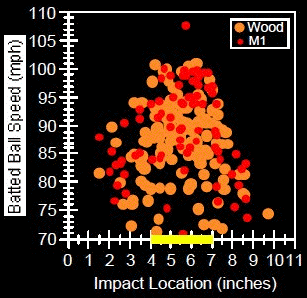 |
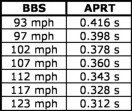 The table at left compares the available pitcher reaction times (the time for the ball to travel 54 feet from the bat to the pitcher) for a range of batted-ball speeds. The calculations show that a ball leaving a bat at 97-mph, corresponding to the professional quality wood bat used to set the NCAA standard, will arrive at the pitcher's mound in just under 4-tenths of a second, while a ball hit from the highest performing metal bat currently allowed by NCAA rules would arrive two-hundredths of a second sooner (0.02s). And the difference in arrival times corresponding to a 10-mph difference in batted-ball speeds is only 0.038 seconds.
To help provide a perspective for the 0.020s difference in arrival times for balls hit with metal and wood bats, consider that it takes 0.095s to blink an eye[11]. In other words, the difference in arrival times between a ball hit by a wood bat and a ball hit by a high performance NCAA approved metal bat is only one-fifth of the time required to blink an eye! And the difference in the arrival times associated with a 10-mph faster batted-ball speed is less than half of the time required to blink an eye.
The table at left compares the available pitcher reaction times (the time for the ball to travel 54 feet from the bat to the pitcher) for a range of batted-ball speeds. The calculations show that a ball leaving a bat at 97-mph, corresponding to the professional quality wood bat used to set the NCAA standard, will arrive at the pitcher's mound in just under 4-tenths of a second, while a ball hit from the highest performing metal bat currently allowed by NCAA rules would arrive two-hundredths of a second sooner (0.02s). And the difference in arrival times corresponding to a 10-mph difference in batted-ball speeds is only 0.038 seconds.
To help provide a perspective for the 0.020s difference in arrival times for balls hit with metal and wood bats, consider that it takes 0.095s to blink an eye[11]. In other words, the difference in arrival times between a ball hit by a wood bat and a ball hit by a high performance NCAA approved metal bat is only one-fifth of the time required to blink an eye! And the difference in the arrival times associated with a 10-mph faster batted-ball speed is less than half of the time required to blink an eye.
I find it very hard to believe having an extra 0.020s to react to a line drive would make any difference in whether or not a pitcher would be able to protect himself. When we look at the actual physical reaction times of players below, I think the inescapable conclusion must be that banning metal bats will not necessarily enable pitchers to avoid being hit by line drives hit directly towards them. The difference in arrival times corresponding to a 5-mph difference in batted-ball speeds is just not large enough to justify a claim that restricting players to using wood bats would make the game safer based on the argument that using wood bats would allow players sufficiently more time to react to a hit ball.
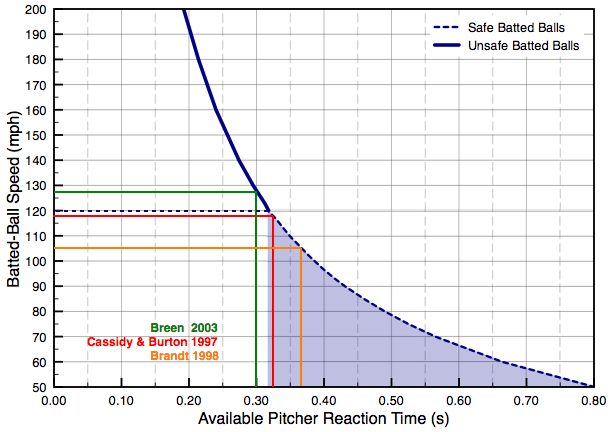 In 1989 P.E. Cassidy and A.W. Burton at the University of Minnesota investigated the response times of college baseball pitchers and infielders in an unpublished dissertation[13] I haven't yet been able to obtain a copy of this dissertation to read it myself, but Dr. Trey Crisco summarized their conclusions in his report to the NCAA[14]. Cassidy and Burton apparently surveyed the available literature on human reaction times in sports activities, and concluded that an average college baseball player is able to begin an accurate response to a batted ball within 0.125s of the ball being hit, and can complete a reasonable movement to catch, deflect or avoid the ball in an additional 0.200s. The total reaction time for a college player, according to Cassidy and Burton, is about 0.325 seconds.
In 1989 P.E. Cassidy and A.W. Burton at the University of Minnesota investigated the response times of college baseball pitchers and infielders in an unpublished dissertation[13] I haven't yet been able to obtain a copy of this dissertation to read it myself, but Dr. Trey Crisco summarized their conclusions in his report to the NCAA[14]. Cassidy and Burton apparently surveyed the available literature on human reaction times in sports activities, and concluded that an average college baseball player is able to begin an accurate response to a batted ball within 0.125s of the ball being hit, and can complete a reasonable movement to catch, deflect or avoid the ball in an additional 0.200s. The total reaction time for a college player, according to Cassidy and Burton, is about 0.325 seconds.
In 1998 Dr. Richard Brandt, a physics professor at New York University, conducted an experimental study of physical reaction times for college baseball players.[15] A total of 320 balls were fired from a pitching machine at speeds between 85 and 105 mph towards 8 different college pitchers. The subjects were standing behind a protective screen at distances 20, 30, 40, and 50 feet from the pitching machine. Subjects were not able to determine the direction at which the ball was being aimed, and the subjects were tested to see whether or not they could successfully deflect a ball being fired towards them (the protective screen prevented the subjects from being injured). Dr. Brandt found that for college baseball players, a minimum of 0.368 seconds was sufficient to successfully deflect an approaching ball. Dr. Brandt's results suggest that a college pitcher should have sufficient time to avoid being hit at 97-mph by a ball hit from a wood bat, ball hit at 102-mph from a legal high performance metal bat, and even a ball hit by a wood or metal bat with a batted-ball speed of 110-mph.
In 2003 Kevin Breen conducted an unpublished study of potential response time of college baseball pitchers to balls hit in their direction.[16] This study used actual pitchers and batters. The pitcher threw the ball and then had to react from his follow-through position and attempt to deflect the ball batted back directly towards him. Breen's study found that the average response time (the time between the ball was hit and the pitcher first began to move in response to seeing the ball) was 0.176s. When this response time was added to the time the pitcher took to move his body to avoid or deflect the batted ball, he found that every pitcher in his study was able to successfully avoid or deflect a batted ball within 0.300 seconds. This corresponds roughly to a batted-ball speed of 123-mph. Breen estimated that a 5-7 mph difference in batted ball speed would amount to a difference in arrival times of 0.015-0.023s which he concluded is far too short a period of time to make any difference as to whether or not a pitcher could avoid being hit by a batted ball. Mr. Breen's study suggests that college pitchers have enough time to react to balls hit by both wood and metal bats at speeds typical of the college game.
A very interesting observation from Mr. Breen's study is his conclusion that . . .
| . . .the largest determining factor in whether a pitcher will be struck by a batted ball is whether the pitcher puts himself in a position to field the ball after delivery. Pitchers are coached to finish their follow through in a way that allows them to be in a position to field any ball that might be hit their way. If a pitcher fails to pitch in a manner so as to be prepared to field, there is a risk that the pitcher will be hit regardless of whether the ball is struck by an aluminum or wood bat. This is because a pitcher who improperly positions himself upon throwing a pitch can easily add well over 0.1 seconds to his reaction time. |
If we summarize the results of these three studies we find that a college pitcher should be able to react and either deflect or avoid a ball hit at 120-mph, and would certainly be able to avoid being struck by a ball hit at 110-mph. Thus, a college pitcher should be able to react to the majority of balls hit by both wood and metal bats. However, if the pitcher is out of position so that he is not ready to field a ball hit directly towards him, he might not have enough time to avoid being struck by balls hit by wood or metal bats at speeds as low as 90-mph.
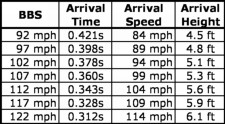 What I do find of interesting with regards to the discussion of injury risk are the speed with which the ball is still traveling and the height above ground when the ball reaches the position of the pitcher. These are results that I have not yet seen discussed at all in any arguments regarding pitcher safety, but they seem to me to be of considerable potential importance in determining the potential severity of injury to a player who is struck by a ball. While the difference in arrival times may not be enough to make a difference in whether or not a pitcher can avoid being hit, the speed with which the ball impacts the pitcher and the location of the impact could affect the severity of an impact injury. My calculations show that an increase of 5-mph in the batted-ball speed means that the ball will also be traveling about 5-mph faster upon impact.
In addition, the faster ball will also strike the pitcher about 4 inches higher on his body.
What I do find of interesting with regards to the discussion of injury risk are the speed with which the ball is still traveling and the height above ground when the ball reaches the position of the pitcher. These are results that I have not yet seen discussed at all in any arguments regarding pitcher safety, but they seem to me to be of considerable potential importance in determining the potential severity of injury to a player who is struck by a ball. While the difference in arrival times may not be enough to make a difference in whether or not a pitcher can avoid being hit, the speed with which the ball impacts the pitcher and the location of the impact could affect the severity of an impact injury. My calculations show that an increase of 5-mph in the batted-ball speed means that the ball will also be traveling about 5-mph faster upon impact.
In addition, the faster ball will also strike the pitcher about 4 inches higher on his body.
There is published research on the severity of injury for baseball impacts indicating that "the severity and frequency of injury increases as impact velocities increase."[14] Additional research indicates that lowering the compression of the balls being used can reduce the severity of injury by a greater degree than lowering the batted-ball speed.[17-18] This suggests that an organization or group truly concerned about safety and the risk of injury to pitchers and infielders might be better off arguing for the use of lower compression balls instead of attempting to ban metal bats. Both wood and metal bats are capable of hitting balls at high speeds, speeds which could cause serious injury upon impact. Using a lower compression ball would significantly reduce the potential severity of an injury, even if the ball was travelling at a high speed after being hit by a wood or metal bat.